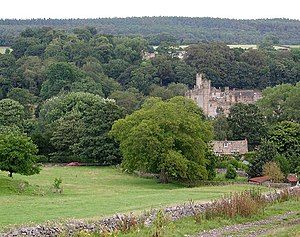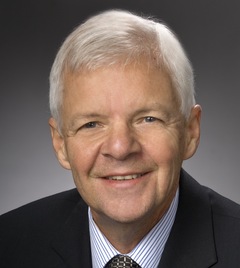In the venerable British tradition of estate naming, we call our house Haddon Hall. We named it that because we live on Haddon Road in Columbus, Ohio, also in tribute to a beautiful English medieval castle by that name. We would love to put up a sign that says that HADDON HALL — perhaps carved on a big rock or stone tablet, or engraved on a brass plate.
Our Haddon Hall is home to us, but we also identify ourselves as its residents by means of the brass knocker on our front door. It says, in mixed case and a classy serif font, Newton, because that’s our name. We see no need to add anything more. The meaning is clear.
Signage is written in an extreme form of headline style, the type of writing used in titles of newspaper articles, where the objective is to say exactly what is needed using as few words and letters as possible.
Sometimes context fills in meaning that culturally literate readers are expected to supply for themselves. For instance, if you drive anywhere in the United States and see a thirty-inch wide octagonal sign with white letters in Helvetica Narrow Bold font,[1] and a white border on a red background that says STOP, you know what it means. “The law requires you to bring your vehicle to a full stop right here.” But heaven help us all if we had to read all that on a sign. The simple imperative without punctuation is sufficient to communicate the desired conduct.
Returning to houses, think about the variations of style we observe on signs naming their residents. I first became conscious of this thirty-three years ago by means of a painted ceramic plaque above the door at the home of some friends named Olson. They are both now deceased, so I’ll honor their memory by using them as an example, while also poking fun at them posthumously, because their sign was wrong.
The simplest and most logical identifier would have been just the family name: Olson. Because Olson is commonly recognized as a name, no further explanation is needed to explain that’s the name of the people who live there. It could also have said Eggs, because they raised chickens and sold the eggs. Few people would have mistaken a sign with that word as someone’s name, particularly inasmuch as you had to drive right by the chicken yard to get to the house.
The Olsons, with the definite article and plural family name would have been acceptable, even though it says more than is needed. It suggests the sentence, “The Olsons live here,” or “The Olson family lives here.”
Olsons in the plural is marginally acceptable, but with some names may be ambiguous. Is it really plural, or is the final s part of their name? I found numerous examples among the commonest surnames where both the spelling with and without the “s” are common: Meyer and Meyers; Owens and Owen; Richard and Richards; Wood and Woods, and so forth. Specifying the definite article along with the correct plural form removes all doubt.
The Olson’s Bzzt! Wrong! (What was on my friends’ door.) Any form using an apostrophe forms the possessive, in this case, possession by one single Olson. The implied sentence is “This is the home belonging to the Olson,” meaning the one and only Olson in the whole wide world; and seems to present a question fragment: “The (one and only) Olson’s . . . what?” But there are many Olsons, and in this and most other cases there was more than one Olson to be found living behind these walls.
The Olsons’ is the plural possessive, and like the previous example, seems to ask a question, but in this case suggests the meaning is “The Olsons’ house.” There’s nothing grossly incorrect with this, but it looks wrong. Why slant the identification toward the structure, when the purpose of the sign is likely to identify the residents, not house itself?
I’m all for using the simplest form possible in such signage.
[1] You may not know the font, but you’ll notice if it’s something else. In fact, sometimes we see stop signs on private property (in malls) that are not provided by official sources, and that sometimes look slightly different. I remember coasting through one of those once, whereupon Suzy admonished me that I missed the sign. I told her, “Show me a real stop sign and I’ll show you a real stop.”



